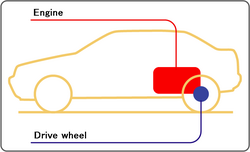RMR layout
In automobile design, an RMR or Rear Mid-engine, Rear-wheel drive layout is one in which the rear wheels are driven by an engine placed just in front of them, behind the passenger compartment. In contrast to the rear-engined RR layout, the center of mass of the engine is in front of the rear axle. This layout is typically chosen for its low polar inertia and relatively favorable weight distribution (the heaviest component is near the center of the car, making the main component of its moment of inertia relatively low). The layout has a tendency toward being heavier in the rear than the front, which allows for best balance to be achieved under acceleration. It is felt that the low polar inertia is crucial in selection of this layout. The mid-engined layout also uses up central space, making it impractical for any but two-seater sports cars.
In modern racing cars, RMR is the usual configuration and is usually synonymous with "rear engine". Due to its favorable weight dynamics, this layout is heavily employed in Formula racing cars (such as F1s). This configuration was also common in very small engined 1950s microcars, in which the engines did not take up much space. Because of successes in racing, the RMR platform has been popular for road going sports cars despite the inherent challenges of design, maintenance and lack of cargo space.
History
The 1923 Benz Tropfenwagen was the first race car with mid-engine, rear-wheel drive layout. It was based on an earlier design named Rumpler Tropfenwagen in 1921 made by Edmund von Rumpler, an Austrian engineer working at Daimler. The Benz tropfenwagen was designed by Ferdinand Porsche along with Willy Walb and Hans Nibel. It raced in 1923 and 1924 and was most successful in the Italian Grand Prix in Monza where it stood fourth. Later, Ferdinand Porsche used mid-engine design concept towards the Auto Union Grand Prix cars of the 1930s which became the first winning RMR racers. They were decades before their time, although MR Miller Specials raced a few times at Indianapolis between 1939 and 1947. In 1953 Porsche premiered the tiny and altogether new RMR 550 spyder and in a year it was notoriously winning in the smaller sports and endurance race car classes against much larger cars—a sign of greater things to come. The 718 followed similarly in 1958. But it was not until the late 1950s that RMR reappeared in Grand Prix (today's "Formula One") races in the form of the Cooper-Climax (1957), soon followed by cars from BRM and Lotus. Ferrari and Porsche soon made Grand Prix RMR attempts with less initial success. The mid-engined layout was brought back to Indianapolis in 1961 by the Cooper Car Company with Jack Brabham running as high as third and finishing ninth. Cooper did not return, but from 1963 on British built mid-engined cars from constructors like Brabham, Lotus and Lola competed regularly and in 1965 Lotus won Indy with their Type 38.
Cars using the RMR layout
Pre-1960s
- Rumpler Tropfenwagen (1921), first ever production road car with RMR layout and the first streamlined car too, 100 produced
- Porsche 550 Spyder (1954), 125 produced (including 90 road versions)
- Zündapp Janus (1957), literally mid-engined and nearly symmetrical with passengers on both ends of the engine
1960s to 1970s
- De Tomaso Pantera (1971–1996)
- De Tomaso Vallelunga (1965–1967)
- Ferrari Berlinetta Boxer
- Ferrari Dino 206/246 (1968)
- Ferrari 308
- Ferrari GT4
- Fiat X1/9, (1972–1989) 160,000 produced
- Ford GT40 (1966)
- Lamborghini Countach (1974–1990)
- Lamborghini Miura (1966–1974) 987 produced
- Lamborghini Urraco (1973–1979) 791 produced
- Lancia Monte Carlo (1975–1981)
- Lotus Europa (1966–1975) 9300 produced
- Lotus Esprit (1976–2004)
- Matra Djet (1962–1968) 1,692 produced
- Matra M530 (1967–1972) 9,609 produced
- Matra Bagheera (1973–1980) 47,802 produced
- Maserati Bora (1971–1980)
- Maserati Merak (1974–1982)
- Porsche 914 (1969) 118,000 produced
1980s to 1990s
- Ferrari 328
- Ferrari 348
- Ferrari F355
- Ferrari 360
- Ferrari Mondial
- Honda Acty
- Honda Beat
- Honda NSX (AKA Acura NSX in North America)
- Lamborghini Diablo
- Matra Murena
- Mazda Autozam AZ-1
- MG F
- Pontiac Fiero
- Porsche Boxster
- Renault 5 Turbo
- Toyota MR2
- Toyota Previa
2000s
- Clio V6 Renault Sport
- Ferrari 360
- Ferrari F430
- Honda NSX (AKA Acura NSX in North America)
- Lotus Elise
- Lamborghini Gallardo
- Mitsubishi i
- Opel Speedster
- Porsche Boxster
- Porsche Cayman
- Toyota MR-S (AKA Toyota MR2 Spyder in North America)
- Westfield XTR2
- Westfield XTR4
Supercars
- Enzo Ferrari
- Ferrari 288 GTO
- Ferrari F40
- Ferrari F50
- Ferrari FXX
- Ford GT
- Honda NSX Type-R
- Jaguar XJ220
- Koenigsegg CCX
- Lamborghini Murciélago
- Lotus Exige S
- Maserati MC12
- McLaren F1
- Pagani Zonda
- Porsche 911 GT1 (Road Version)
- Porsche Carrera GT
- Saleen S7
- Spyker C8
References
- wspr-racing.com/wspr/results/canam/nf_canam_home.html
- www.indycar.com/multimedia/photos/galleries.php
- www.ddavid.com/formula1/rcg.htm
- www.chaparralcars.com
- www.racingsportscars.com/photo_lemans.html
- Porsche Spyder MR detail www.spyderclub.com/articles/spyder_history/spyder_history.htm
- http://www.forix.com/8w/rear-engines-prewar.html
- NSX-R Article at Autozine [1]
| Automobile layouts |
|---|
| Layouts: |
| FF | FMR | FR | MF | RMR | RR | F4 |
| Engine positioning: |
| Front-engine | Mid-engine | Rear-engine |
| Drive: |
| Front-wheel drive | Rear-wheel drive | Four-wheel drive | Six-wheel drive |
